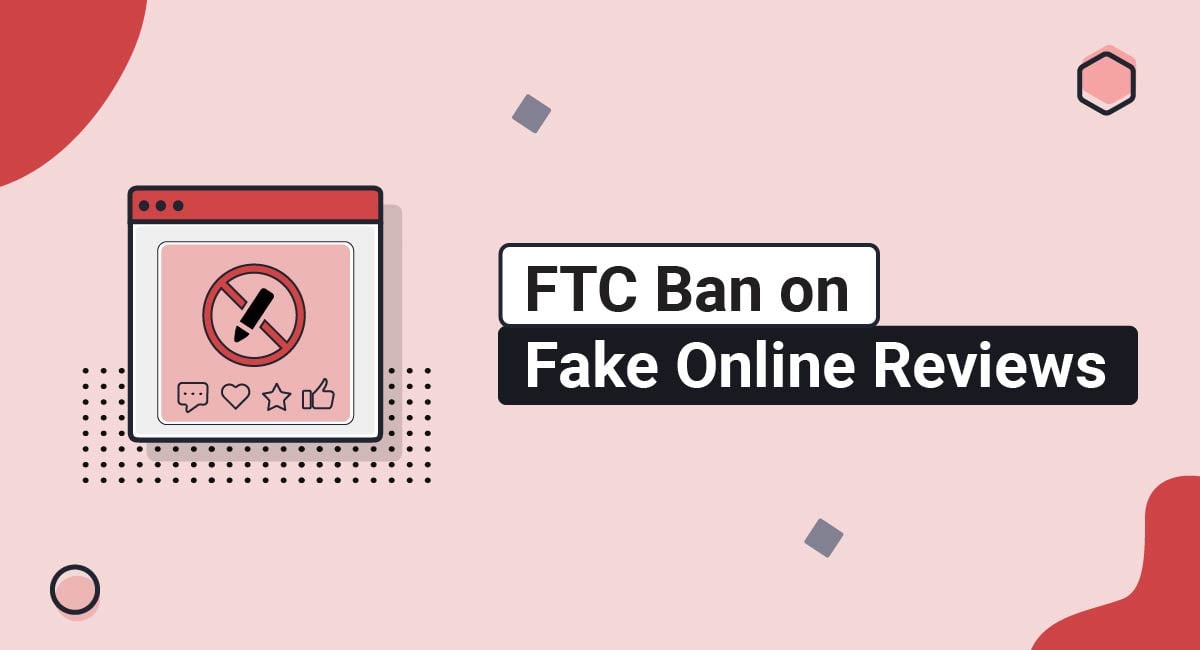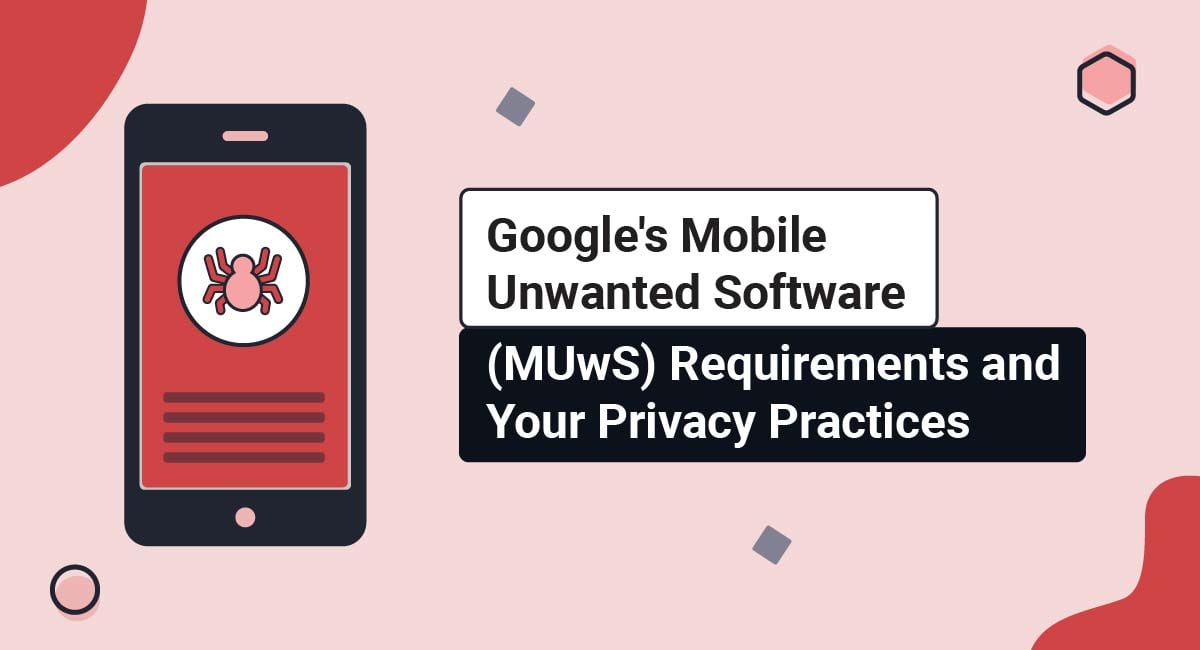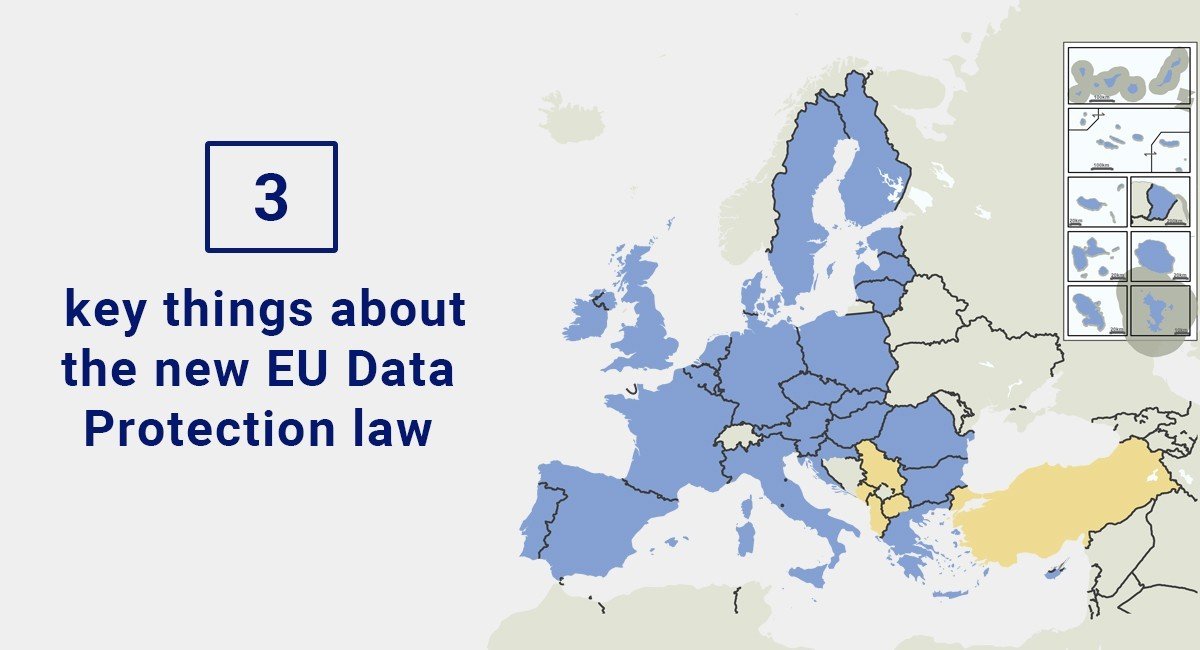In August of 2024, the U.S. Federal Trade Commission (FTC) announced a final rule to combat fake online reviews, which went into effect in October of 2024. Its purpose is to prevent unfair, deceptive or misleading conduct.
The new rule bans the sale or purchase of fake reviews for businesses and services, and the FTC will enforce penalties against companies that are found to be breaching the rule.
This article will cover who this new rule applies to, what it requires, and how you can comply with it. It includes actionable steps and guidance for your business so that you can make sure you are prepared for the FTC's new rule and its effects.
- 1. Who Does the FTC Fake Online Review Rule Apply to?
- 2. What Does the FTC's Rule Require?
- 3. How Do You Comply with the Rule Banning Fake Online Reviews?
- 3.1. No Fake Reviews
- 3.1.1. Inform Your Users with Terms and Conditions
- 3.1.2. Get Affirmative Consent for Your Terms and Conditions
- 3.1.3. Create a Process for Verifying Reviews
- 3.2. No Buying Reviews
- 3.2.1. Be Careful About Gifts or Offers
- 3.3. No Insider Reviews
- 3.3.1. Disclose Any Connections in Reviews
- 3.3.2. Inform Your Employees
- 3.3.3. Remove Non-Compliant Insider Reviews
- 3.4. Don't Create Review Websites that Include Your Own Products
- 3.5. No Suppressing Negative Reviews
- 3.5.1. Display Both Positive and Negative Reviews
- 3.6. No Fake Social Media Engagement
- 3.6.1. Look For Fake Engagement and Remove Bots
- 4. What are the Penalties for Violating this Rule?
- 5. Summary
Who Does the FTC Fake Online Review Rule Apply to?
The FTC's new rule banning fake online reviews applies to businesses, which it defines as "an individual, partnership, corporation, or any other commercial entity that sells products or services."
The rule notes explicitly that this includes marketing agencies, advertisers, advertising agencies, PR firms, review brokers, and reputation management companies.
Platforms that only publish reviews (e.g. for other businesses) do not need to check whether the reviews are real or fake.
If your website sells products or services for which customers can leave reviews, you'll need to understand your obligations. Let's take a look at what the rule requires.
What Does the FTC's Rule Require?
The FTC's rule prohibits a number of different deceptive, unfair, or misleading practices relating to online reviews. Some of these relate to creating fake positive reviews, while others relate to the suppression of negative reviews.
The full list of banned actions from the FTC's new ban on fake online reviews is as follows:
- No fake reviews
- No buying reviews
- No insider reviews
- No review websites appearing to be independent, that actually review the company's own product
- No suppressing negative reviews
- Fake social media engagement
We'll go through each of these parts in more detail below, as well as guidelines and steps you can take to comply with each one.
How Do You Comply with the Rule Banning Fake Online Reviews?
To comply with the FTC's new rule, you'll need to make sure that you are not unintentionally manipulating reviews for your business in any way. Let's go through each of the requirements from the FTC's new rule.
No Fake Reviews
To prevent fake reviews, you'll need to:
- Inform your users about rules for posting reviews with your Terms and Conditions agreement
- Get affirmative consent to your Terms and Conditions agreement
- Create a process for verifying reviews
The FTC's rule explains that "fake or false" reviews or testimonials are prohibited:
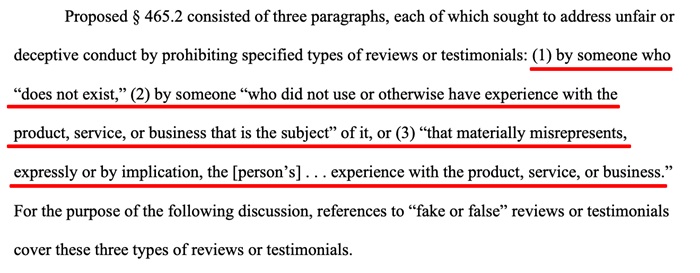
You can see in the text above that this includes:
- Reviews made by people who don't exist (whether manually created or AI-generated)
- Reviews made by people who did not have actual experience with the business or its products or services
- Reviews that lie about the product or service experience
You cannot create or buy such reviews, including from company insiders. You also cannot disseminate, i.e. share or spread, fake reviews or testimonials (e.g. in your marketing materials), if you "knew or should have known" that they were fake.
Here are a few ways you can prevent your website from having fake reviews on it.
Inform Your Users with Terms and Conditions
If you allow your website users to submit product reviews, it's a good idea to inform them that misleading or fake reviews are not allowed and will be removed. You can include this in your Terms agreement that you display on your website, and possibly link to it during the process of submitting reviews.
For example, TrustPilot has Terms of Use for the submission of reviews to its service. One section, which you can see below, explains that leaving fake reviews is not permitted:
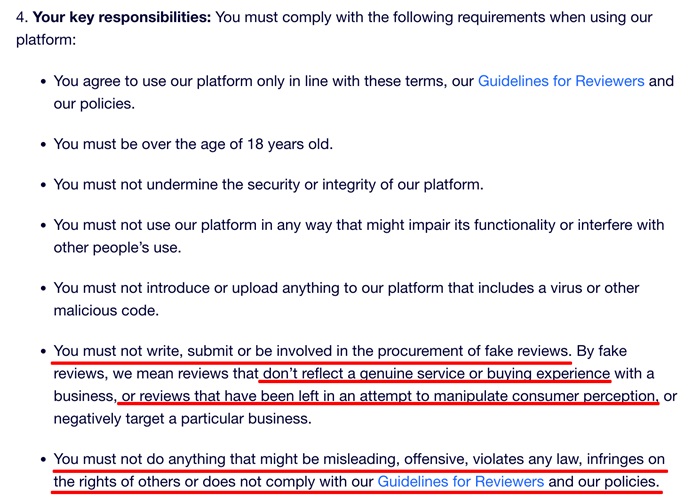
TrustPilot also has a document titled "Guidelines for Reviewers." This helps to expand on the requirements for users and make it clear what is allowed and what is not. Here's an excerpt:

You can see above that TrustPilot prohibits fake reviews, and in its guidelines explains that you also shouldn't post reviews if you are closely associated with (or in competition with) a company. It also notes that receiving incentives for writing, changing, or deleting reviews is not allowed. You can use similar sections in your own Terms and Conditions or guidelines for users.
Here's how IKEA explains in its Product Review Terms and Conditions that fake reviews are not permitted:
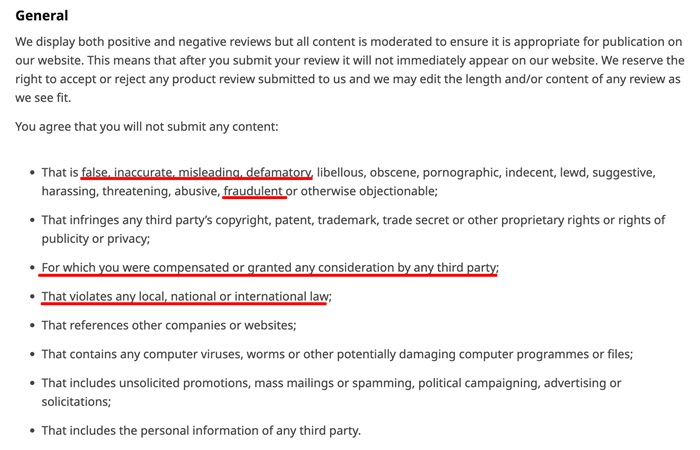
Here's another example from the Google Store review guidelines that includes some of the actions Google will take if you submit a fake review:
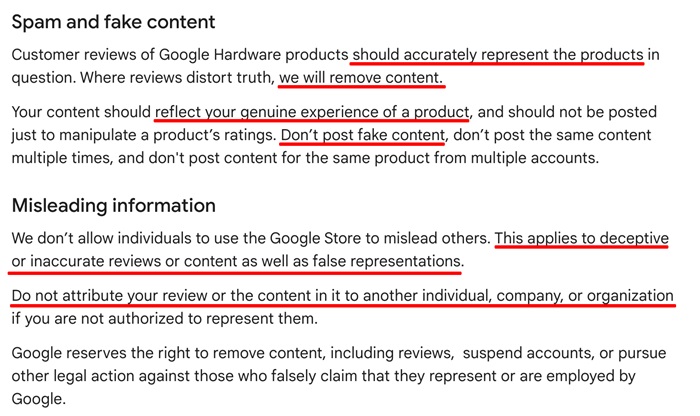
Together, documents like Terms and Conditions as well as guidelines for reviewers help to make sure that reviews are good quality, and that your users are more likely to submit reviews that are in line with the FTC's new rule.
Get Affirmative Consent for Your Terms and Conditions
Display your Terms agreement and get users to consent to it.
Here are a few places to display the agreement:
- In your website footer or menu
- On forms and near text entry boxes when your users submit a review
Here's an example that shows where you can display your Terms and Conditions on your form for submitting a review:
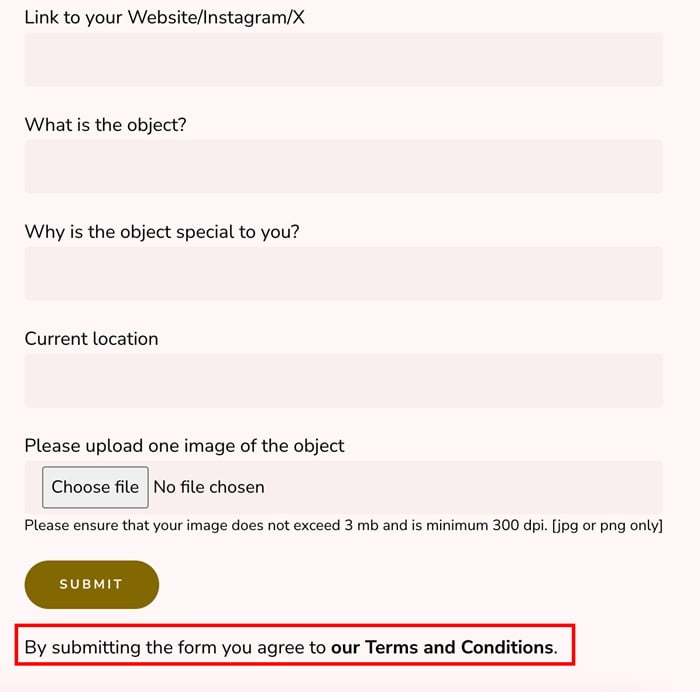
Include a consent checkbox that can be checked by the user to show consent, such as used here by Lenovo:

Create a Process for Verifying Reviews
Even once you've set up your Terms and Conditions, you'll still need to make sure that you have some process for verifying reviews as much as you are able to.
This is because the standard of the FTC's rule is "knew or should have known" that a review was fake or produced by a company insider. Even with good Terms and Conditions, having an extra step to verify reviews is important.
One step for verifying reviews is only allowing the user to submit their review through a user account, which shows that they purchased the product through their account.
This is the approach taken by Amazon, for example, which you can see below:
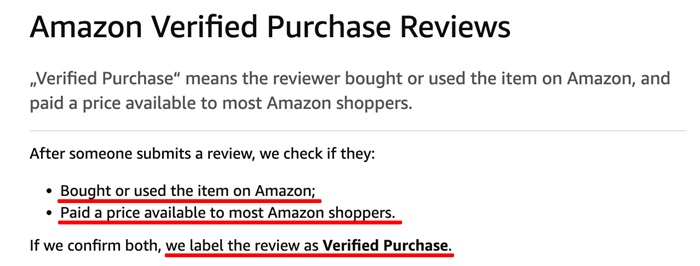
In addition, you can also use form submissions like this example from Feefo below, which requires the reviewer to submit information such as name, email address, date of purchase, order number, and a proof of purchase e.g. an email confirmation or receipt:
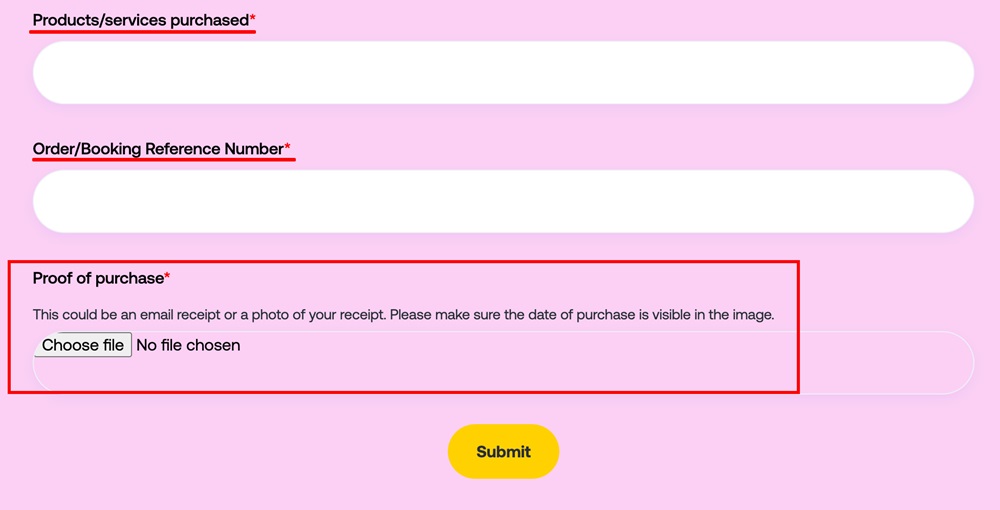
Even with these measures in place to ensure that reviews are made by people who actually bought the product, you'll still need to check that reviews don't contain fake or misleading content.
No Buying Reviews
The rule says that you are not allowed to buy reviews, or offer compensation or incentives for posting reviews. This applies regardless of whether the review is good or bad (e.g. paying to review a competitor badly).
To comply with this section:
- Don't pay for any good reviews for your business, or bad reviews for a competitor
- Do not offer your customers gifts, rewards, or incentives for leaving reviews
- Offer any "thank yous"; for your customers only after the fact, sporadically, and do not advertise this practice
You can see the text of the rule below:
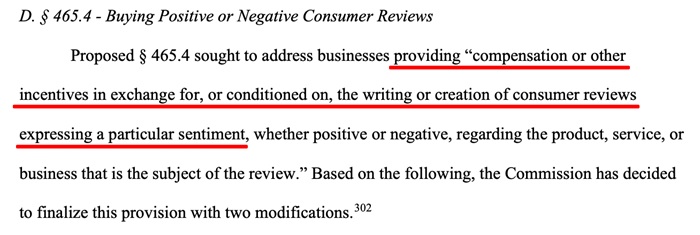
Modifications were added to the initial text of the rule above to make it clear that the incentive can be explicitly told (e.g. "I will give you $500 to make the review"), or implicit (i.e. hinted at or suggested, e.g. "There might be a payoff for you if you do this").
Be Careful About Gifts or Offers
While it might be tempting to offer your customers something nice in exchange for submitting a review, incentives for reviews are not permitted by the FTC's new rule.
You can see in this example from IKEA how it explicitly says users receive nothing in exchange for leaving a review:

If you want to offer your customers a "thank you" in exchange for leaving a good review, such as a gift card, only send them the reward or gift card after the good review has already been created of their own volition, without any influence or advertising from your website about this practice.
This way, you can show your customers you appreciate their feedback, without falling afoul of the rule. You'll have to be careful that this is a rare occurrence though, or it could look like "implicit" influence, if it becomes known to the public that you do this as a common practice.
No Insider Reviews
Insider reviews (i.e. from people with a "material connection" to your business) are not allowed, unless you disclose the relationship between the reviewer and the company "clearly and conspicuously."
This includes reviews or testimonials from officers or managers, or from people that you should have known were officers, managers, employees or agents.
To comply with this part of the FTC's new rule you'll need to:
- Disclose any relevant connections to your company in any reviews made by managers, officers, employees and agents
- Inform your managers, officers, employees and agents that they cannot leave reviews without disclosures
- Inform these same people that they cannot ask their family members for reviews without disclosures
- Remove any insider reviews you find
You can see this mentioned in the rule below:
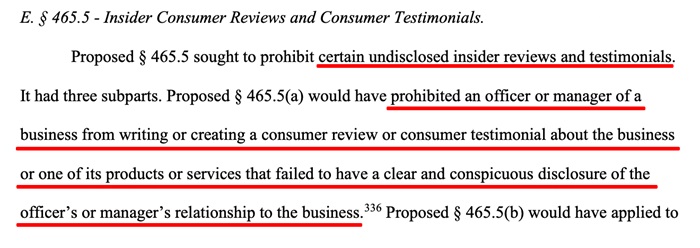
Disclose Any Connections in Reviews
If you do have anyone "on the inside" leaving a review, this must include a clear and conspicuous disclosure of the relationship.
For example, the review can start with text like this:
"Disclaimer: I am an employee of this company."
Inform Your Employees
You'll need to make sure that you have internal processes for your business, so that your employees know that reviews by them, or their family members, are not allowed.
These internal processes for your company can also, for example, include training for your staff members so that they know they cannot buy reviews, suppress negative reviews by removing them from your website, or purchase misleading or fake social media engagement.
These people are also not allowed to ask for reviews from their immediate relatives without a disclosure.
Managers and officers are not allowed to tell employees or agents to ask for reviews from their immediate relatives, unless they are instructed to also include a disclosure.
Remove Non-Compliant Insider Reviews
If you find any insider reviews that don't include an appropriate disclosure, you need to take "remedial steps" to remove the reviews.
Don't Create Review Websites that Include Your Own Products
You are not allowed to create "independent review" websites or services to review your own business or products.
This would be like creating a website that you run yourself, to review your own other website.
Here's how this is stated:
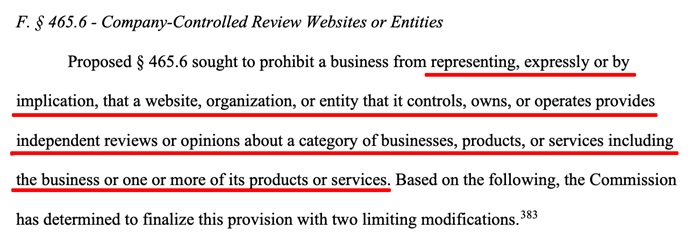
In most cases, normal websites or ecommerce stores would not need to worry about falling afoul of this part of the rule accidentally as this would usually be intentional conduct.
No Suppressing Negative Reviews
Suppressing negative reviews is not permitted.
You may not:
- Threaten people or intimidate people either to not post a negative review, or to remove one that already exists
- Present only positive reviews on your website
Here's how this is stated:
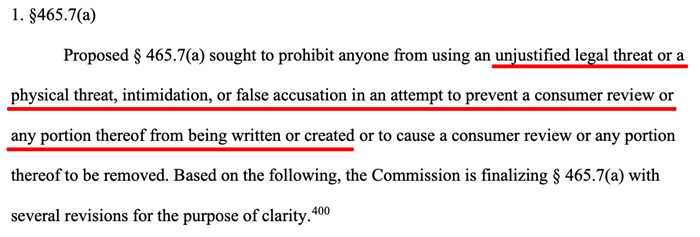
Display Both Positive and Negative Reviews
If you display positive reviews on your website, you are also not allowed to act as if these are the only reviews that exist.
Here's this section of the rule:
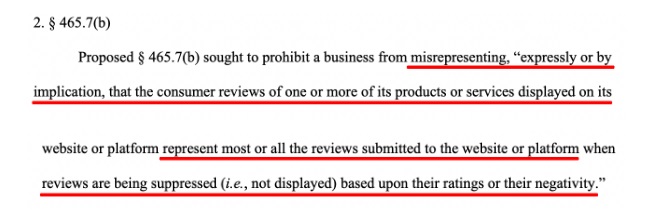
Negative reviews should also be accessible and it must be clear that the positive reviews are just a portion of the total reviews.
Here's an example from H&M showing some reviews for a jacket. You can see that both positive and negative reviews are displayed:
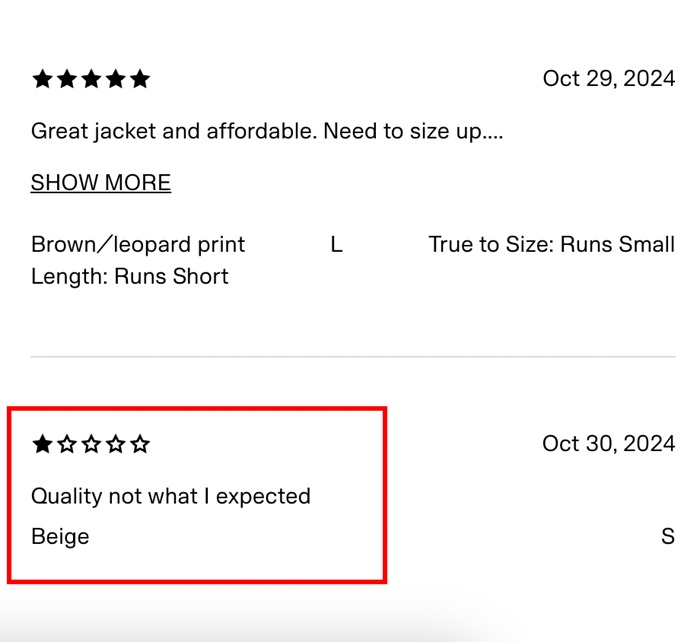
When you post reviews on your website, you need to include a clear statement, for example, that this is just a sample of positive reviews, and ideally provide a link to the rest of the reviews somewhere as well.
Here's another example from Hotel Edelweiss in Italy, which displays a selection of reviews from its customers, with a link to read more reviews on Trip Advisor:
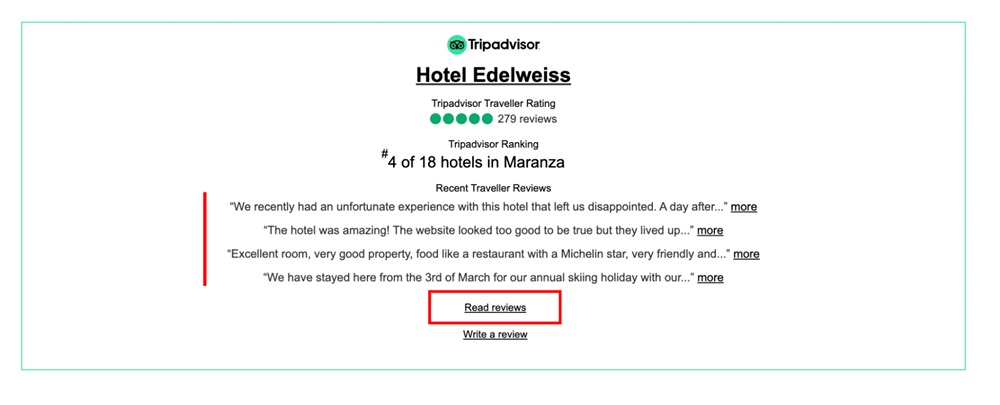
Displaying reviews on your website like this, both good and bad, will make sure you comply with this part of the FTC's new rule.
No Fake Social Media Engagement
Your business may also not buy or sell social media engagement or influence, such as fake followers or views on social media accounts. This is often done by using bots, which are prevalent on many social media websites.
Here's what the rule states on this point:

Of course, sometimes it can be hard to tell if a social media user is real or a bot. This rule only applies if you "knew or should have known" that the social media account or engagement was fake.
Look For Fake Engagement and Remove Bots
If there's a risk that social media engagement such as likes or followers on your accounts could be bots or artificially generated, take steps to remove these as much as possible.
There are a number of ways in which you can tell if a social media account is potentially a bot.
Microsoft outlines some possible signs of fake engagement below:

Take care to notice whether you may have had:
- Sudden increases in likes, followers, or reviews being posted to your pages
- Followers who do not engage with your pages, except to post reviews
- Identical reviews being posted by different users
- Users posting reviews with links or strange text
TechRepublic also explains that you can check:
- User profile pictures and names: Generic icons or no profile picture at all can indicate bots
- Post history: A lack of post history, or "spammy" post history can indicate a bot
- Followers: A high level of fake followers may show that the poster is also fake
- Ratio: If the account has almost no followers, but is following a very high number of other accounts, this is suspicious
You can also use tools like BotSentinel to check for users you suspect may be fake.
When you take all of these steps, you can show that you are doing your best to get into compliance with the FTC's new rule.
What are the Penalties for Violating this Rule?
The FTC rule states that the maximum civil penalty for any of the above violations is currently $51,744 per violation (i.e. per fake review), although in many cases lower penalties would be awarded. This is a high level of potential fines, however.
When the standard in the rule is "knew or should have known," you can show that you took all steps to prevent fake or insider reviews being posted on your website. Then, if there are fake reviews that are discovered, you can show that you didn't know about them and that you also couldn't have discovered these (because you already did everything reasonable to comply). In this case, you are much less likely to be awarded penalties.
Beware of suppressing negative reviews, or purchasing reviews or social media engagement to compete: all businesses who engage in these practices will also have to stop. With the high level of fines that could be given by the FTC, boosting marketing or image in these ways is just not worth it.
Summary
Complying with the FTC's new rule banning fake online reviews may take a few extra steps to get your website into line. But with new Terms and Conditions or amendments to your existing terms, you can notify your users of what is required of them when they submit a review.
In addition, when you verify any reviews posted to your website, and double-check any social media engagement, you'll be in good stead to meet the FTC's requirements.
Make sure your employees and the public are both informed about how you handle reviews, and follow all the steps outlined above to remain compliant.

Comprehensive compliance starts with a Privacy Policy.
Comply with the law with our agreements, policies, and consent banners. Everything is included.
